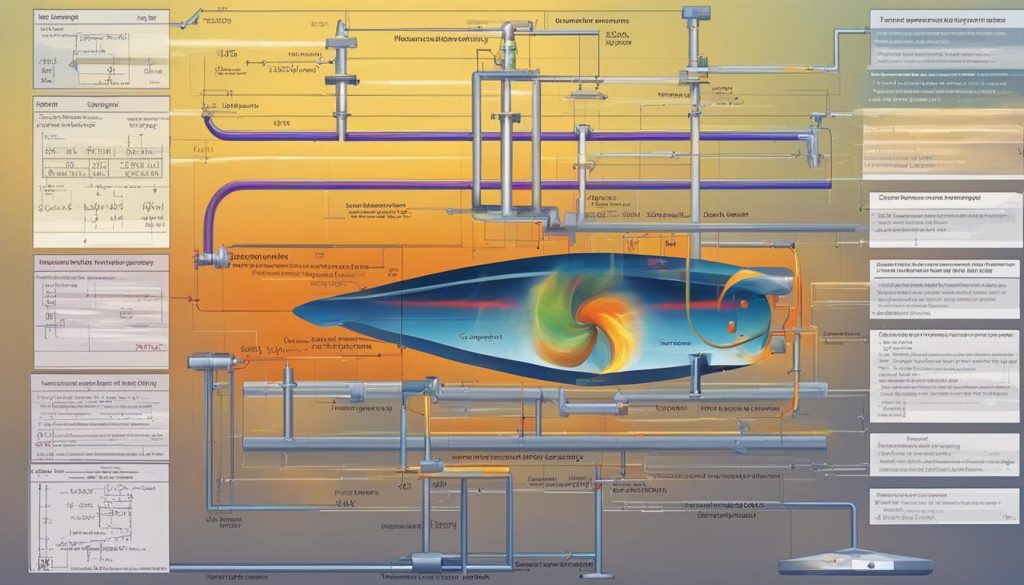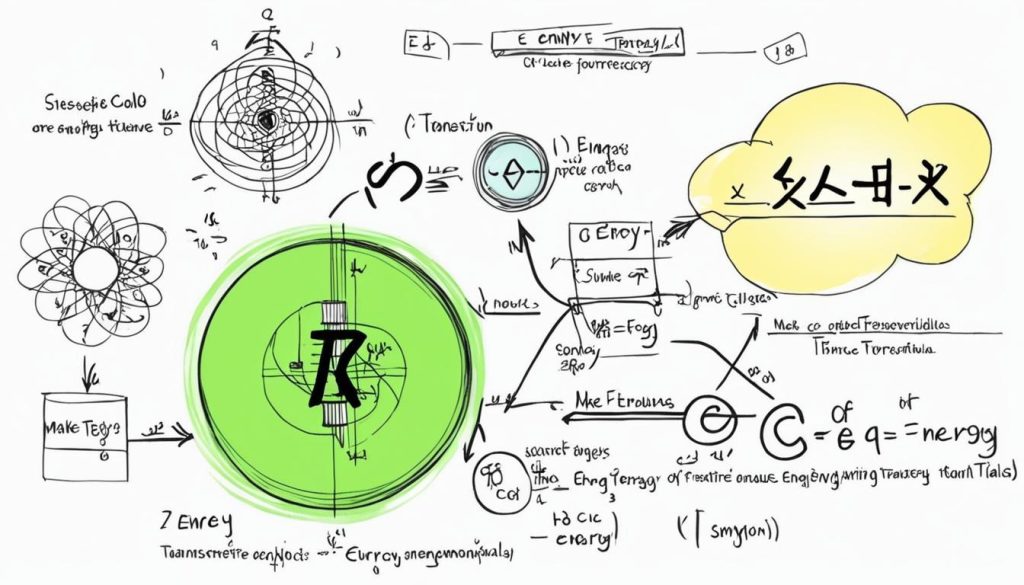Understanding Energy Transferred Equations
Energy transfer is a fundamental concept in physics that helps us comprehend various natural phenomena, from thermal heat exchange to electrical circuits. By studying the flow of energy between systems, scientists can accurately predict the behavior of physical objects and their surroundings. This is where energy transferred equations play a crucial role.
An energy transferred equation defines the amount of energy that is transferred from one system to another. It provides a quantitative representation of energy transfer, enabling scientists to calculate and analyze the transfer of energy in different systems accurately. Energy transferred equations are extensively used in a wide range of scientific fields, including physics, chemistry, and engineering.
Understanding energy transferred equations is essential for comprehending various scientific concepts. In the following sections, we will explore the components of the equation, how to calculate it, and provide practical examples of its application.
Key Takeaways
- Energy transferred equations play a crucial role in understanding energy transfer between different systems.
- The equation provides a quantitative representation of energy transfer, allowing for accurate calculations and analysis.
- Energy transferred equations are widely used in fields such as physics, chemistry, and engineering.
- Understanding energy transferred equations is essential for comprehending various scientific concepts.
- In the following sections, we will explore the components of the equation, how to calculate it, and provide practical examples of its application.
Exploring the Energy Transfer Equation
Understanding the energy transfer equation is crucial in accurately calculating the amount of energy transferred between systems. The energy transfer equation is the mathematical representation of the conservation of energy principle in action. It considers the initial and final states of a system and calculates the energy transferred between them, irrespective of the process involved. The energy transfer equation is commonly used in scientific fields, such as physics, chemistry, and engineering.
The energy transfer equation consists of several components:
- The amount of energy transferred, Q, measured in joules (J)
- The specific heat capacity, c, measured in joules per kilogram Celsius (J/kg°C)
- The mass, m, measured in kilograms (kg)
- The change in temperature, ΔT, measured in Celsius (°C)
Together, these components form the energy transfer formula, Q = mcΔT.
The energy transfer equation has several practical applications, from calculating the amount of heat transferred in a chemical reaction to determining the amount of energy absorbed by a particular material. Consider the following examples:
- Example 1: How much ice (m = 50g) at 0°C can be melted by 3,000 J of energy?
- Example 2: How much energy is required to raise the temperature of a cup of coffee (m = 0.2kg) from 25°C to 85°C?
| Variable | Value |
|---|---|
| c (specific heat capacity of ice) | 2.09 J/g°C |
| ΔT (change in temperature) | 0 to 100°C |
The energy transferred to melt the ice is equivalent to the energy required to raise its temperature from 0 to 100°C, as this is where the ice changes state from a solid to a liquid. Therefore, the equation becomes:
Q = mcΔT = (50g)(2.09 J/g°C)(100°C) = 10,450 J
Therefore, the 3,000 J of energy applied is not enough to melt the entire quantity of ice.
| Variable | Value |
|---|---|
| c (specific heat capacity of coffee) | 4.18 J/g°C |
| ΔT (change in temperature) | 25 to 85°C |
The equation becomes:
Q = mcΔT = (0.2kg)(4.18 J/g°C)(85°C-25°C) = 3,352 J
Therefore, 3,352 J of energy is required to raise the temperature of the coffee from 25°C to 85°C.
By understanding the components of the energy transfer equation and how to use it to solve simple problems, one can unlock its full potential in various scientific fields.

Calculating Energy Transfer
In order to determine the amount of energy transferred between two systems, it is necessary to use the energy transfer equation formula:
Energy Transferred = Mass × Specific Heat Capacity × Temperature Change
This formula provides a measure of how much energy transfers between two objects or systems, taking into account their respective masses, specific heat capacities, and temperature changes. In order to calculate energy transfer, one must follow these steps:
- Determine the mass of the system or object
- Identify the specific heat capacity of the material being transferred
- Measure the temperature difference before and after the transfer
- Plug in the values to the energy transfer equation formula, and calculate
It is important to note that energy transfer can be measured in different units, such as Joules or kilojoules, depending on the magnitude of the transfer. In addition, the temperature change can be positive or negative, depending on whether heat is added or removed from the system or object.
Let’s look at an example to better understand the calculation process. Suppose a 5kg block of copper at 20°C is heated to 120°C. The specific heat capacity of copper is 385 J/kg°C. Using the energy transfer equation formula, we can calculate the amount of energy transferred as follows:
| Variable | Value |
|---|---|
| Mass (m) | 5 kg |
| Specific Heat Capacity (c) | 385 J/kg°C |
| Temperature Change (ΔT) | 100°C |
Plugging in the values, we get:
Energy Transferred = 5 kg × 385 J/kg°C × 100°C = 192,500 J = 192.5 kJ
Therefore, the amount of energy transferred from the heating of the copper block is 192.5 kilojoules.

Conclusion
In conclusion, comprehending energy transferred equations is crucial in several scientific contexts. The energy transfer equation is an essential tool for calculating the amount of energy transferred between systems. This article has explored the energy transfer equation, its definition, formula, and practical applications.
By understanding the components of the energy transfer equation, including the variables and units involved, readers can apply it to different scenarios. Additionally, calculating energy transfer accurately requires following specific steps, which have been discussed in this article.
Overall, the energy transferred equation, energy equation, transfer of energy equation, energy transfer formula, equation for energy transfer, energy transfer equation examples, energy transfer equation definition, energy transfer equation calculation, and energy transfer equation formula are all relevant concepts that play an essential role in various scientific fields. Therefore, readers should ensure they understand these concepts and apply them in their respective fields.
FAQ
What is an energy transferred equation?
An energy transferred equation is a mathematical representation used to calculate the amount of energy transferred between two systems. It provides a quantitative measurement of energy flow and is widely employed in various scientific disciplines.
How is the energy transfer equation formulated?
The energy transfer equation is formulated as:
Energy Transferred = Power × Time
where Power is the rate of energy transfer and Time is the duration over which the transfer occurs. This equation allows scientists and engineers to quantify the energy exchanged between systems.
Can you provide an example of an energy transfer equation?
Certainly! Let’s say we have a light bulb with a power rating of 60 watts (W) and it is being used for 5 hours. We can calculate the energy transferred using the energy transfer equation:
Energy Transferred = Power × Time
Energy Transferred = 60 W × 5 hours
Energy Transferred = 300 watt-hours (Wh)
Therefore, the energy transferred by the light bulb in this example is 300 watt-hours.
What is the significance of the energy transfer equation?
The energy transfer equation is essential for understanding the dynamics of energy flow and exchange in various systems. It allows scientists and engineers to determine the amount of energy transferred, enabling them to make informed decisions and optimize energy usage in different applications.
How can I use the energy transfer equation to calculate energy transfer?
To calculate energy transfer using the energy transfer equation, you need to know the power (P) of the system in watts and the time (t) in seconds, hours, or any other unit of time. Simply multiply the power by the time:
Energy Transferred = Power × Time
This will give you the energy transferred in joules (J) or any other appropriate unit.




